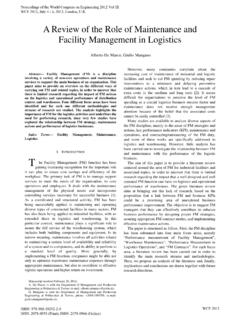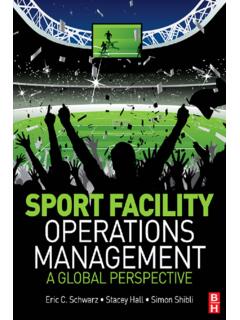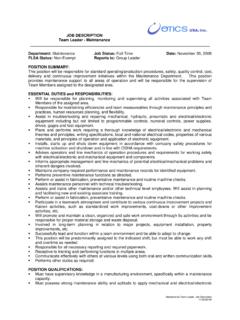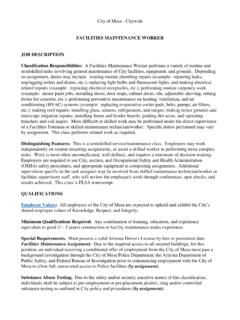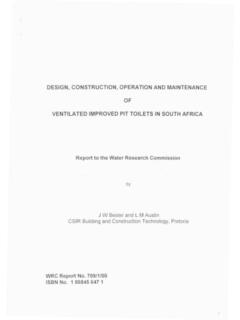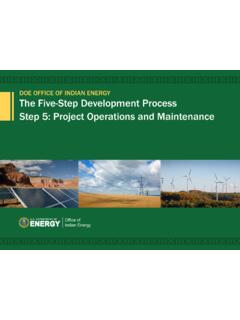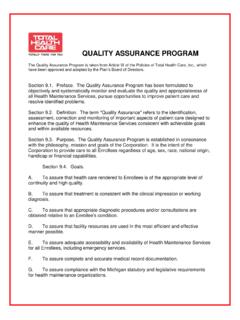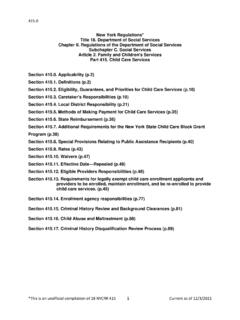Transcription of 11.0 Instrument Equipment Testing, Inspection and …
1 QA Handbook Vol II, Section Revision No: 1 Date: 12/08 Page 1 of 6 Instrument Equipment Testing, Inspection and maintenance Implementing an ambient air monitoring network, with the various types of Equipment needed, is no easy task. Through appropriate testing, Inspection and maintenance programs, monitoring organizations can be assured that Equipment is capable of operating at acceptable performance levels. Every piece of Equipment has an expected life span, and its use should be discontinued if its performance quality ceases to meet appropriate standards. For amortization purposes, EPA estimates a 7 year lifespan for most monitoring instruments and a somewhat longer lifespan for more permanent types of Equipment ( Instrument racks, monitoring shelters etc.). This means that funds for replacing capital Equipment are provided in resource allocations and monitoring organizations should make the best use of Equipment replacement resources.
2 Monitoring organizations may be able to prolong the life of Equipment but in doing so they may run the risk of additional downtime, more upkeep and a greater chance of data invalidation, while losing out on newer technologies, better sensitivity/stability and the opportunities for better information management technologies. Due to the many types of Equipment that can be used in an ambient air monitoring program, this section provides general guidance on testing, Inspection , and maintenance procedures for broad categories of Equipment only. In most cases, Equipment manufacturers include Inspection and maintenance information in the operating manuals. The role of monitoring organizations, in developing a quality system, is to address the scheduling and documentation of routine testing, Inspection , and maintenance . Detailed maintenance documents should be available for each monitoring site. Elements incorporated into testing, Inspection and maintenance documents include: Equipment lists - by organization and station; spare Equipment /parts lists - by Equipment , including suppliers; Inspection / maintenance frequency - by Equipment ; testing frequency and source of the test concentrations or Equipment ; Equipment replacement schedules; sources of repair - by Equipment ; service agreements that are in place; and monthly check sheets and entry forms for documenting testing, inspections and maintenance performed.
3 Instrumentation Analyzers and Samplers Aside from the specific exceptions described in Appendix C of Part 581, monitoring methods used for SLAMS monitoring must be a reference or equivalent method, designated as such by 40 CFR Part 532. Reference or equivalent methods also must be used at NCore monitoring sites intended for comparison with any NAAQS. Among reference and equivalent methods, a variety of analyzer designs and features are available. For certain pollutants, analyzers employing different measurement principles are available. Some analyzer models only meet the minimum performance specifications (see Table 7-5), while others provide a higher level of performance. Section 7 provides information on what aspects to consider when selecting a particular monitoring Instrument /analyzer. Upon receiving the new analyzer, the user should 1 Code of Federal Regulations, Title 40, Part 58, Appendix C, Government Printing Office, 2006.
4 2 Code of Federal Regulations, Title 40, Part 53, Government Printing Office, 2006. QA Handbook Vol II, Section Revision No: 1 Date: 12/08 Page 2 of 6 carefully read the instructions or operating manual provided by the manufacturer. Information or instructions concerning the following should be found in the manufacturer s manual: unpacking and verifying that all component parts were delivered; checking for damage during shipment; checking for loose fittings and electrical connections; assembling the analyzer; installing the analyzer; calibrating the analyzer; operating the analyzer; electrical and plumbing diagrams; preventive maintenance schedule and procedures; troubleshooting; and a list of expendable parts. Many vendors have specific time periods when the initial checks for damage in transit need to be made. The monitor should be assembled and set up according to the instructions in the manufacturer s manual.
5 It may be important to do this initial set-up and testing at the main office or laboratory facility (see Section ) before taking the Equipment to the site. Following analyzer set-up, an initial verification of performance characteristics such as power flow, noise, and response time and a muti-point verification should be performed to determine if the analyzer is operating properly. These guidelines assume that the Instrument was previously calibrated. If the Instrument was disassembled after calibration, or no calibration of the Instrument had previously been performed, the monitor must have a multi-point verification/calibration to ensure it is within acceptable calibration requirements prior to use. Short-term span, zero drift and precision should be checked during the initial calibration or measured using abbreviated forms of the test procedures provided in 40 CFR Part 533. Acceptance of the analyzer should be based on results from these performance tests.
6 Once accepted, reference and equivalent analyzers are guaranteed by the manufacturer to operate within the required performance specifications for one year4, unless major repairs are performed or parts are replaced. In such instances, the analyzers must be recalibrated before use. Support Instrumentation Experiences of monitoring organization staff; preventive maintenance requirements, ease of maintenance and general reliability play crucial roles in the selection of support Equipment . The following examples depict general categories of support Equipment and typical features to look for when selecting this Equipment . This list is meant to guide agencies in the selection of Equipment and does not represent required specifications. Calibration Standards: Calibration standards fall into several categories: - mass flow controlled (MFC) devices; - standards that meet the 1997 Traceability Protocol for Gaseous Calibration Standards5; - permeation devices; - photometers; 3 Code of Federal Regulations, Title 40, Part 53, Government Printing Office, 2006.
7 4 Code of Federal Regulations, Title 40, Part 53, Government Printing Office, 2006. 5 EPA 600/R-97/121: Traceability Protocol for Gaseous Calibration Standards, September 1997 QA Handbook Vol II, Section Revision No: 1 Date: 12/08 Page 3 of 6 - flow measurement devices; - water pressure measurement devices; - barometric pressure measurement devices; and - temperature measurement devices. It is recommended that the devices be 110 VAC, be compatible with data acquisition systems for automated calibrations, and have digital compatibility or true transistor-transistor logic (TTL). The most common standards are MFC devices and permeation devices. Both use dilution air to obtain the needed output pollutant concentration. Data Acquisition Systems (DAS): DAS should have at least 32-bit logic for improved performance (DAS with at least 16-bit logic can still be used); have modem and internet capabilities; allow remote access and control; allow for digital input; and be able to initiate automated calibrations and polling.
8 It is also recommended that DAS have software compatible with AQS and AQI reporting and editing. Both data loggers and analog chart recorders may be used for recording data; however, the storage, communicability, and flexibility of DAS coupled with data loggers makes the DAS systems the preferred option. More information on DAS is found in Section 14. Instrument Racks: Instrument racks should be constructed of steel and be able to accept sliding trays or rails. Open racks help to keep Instrument temperatures down and allow air to circulate freely. Instrument Benches: Instrument benches should be of sufficient space to allow adequate room for multiple instruments with room to work and be capable of supporting a fair amount of weight (> 100 lbs). Slate or other hard, water-proof materials ( , steel) are recommended. Zero Air Systems: Zero air systems should be able to deliver 10 liters/min of air that is free of ozone, NO, NO2, and SO2 to ppm and CO and non-methane hydrocarbons to ppm.
9 There are many commercially available systems; however, simple designs can be obtained by using a series of canisters. Laboratory Support While it is not required, monitoring organizations should employ full laboratory facilities. These facilities should be equipped to test, repair, troubleshoot, and calibrate all analyzers and support Equipment necessary to operate the ambient air monitoring network. In cases where individual laboratories are not feasible, a monitoring organization may be able to find a central laboratory where these activities can be performed. It is recommended that the laboratory be designed to accommodate the air quality laboratory/shop and PM10 and filter rooms, as well as enforcement instrumentation support activities. The air quality portion consists of several benches flanked by Instrument racks. One bench and rack are dedicated to ozone traceability. The other Instrument racks are designated for calibration and repair.
10 A room should be set aside to house spare parts and extra analyzers. A manifold/sample cane should be mounted behind the bench. If possible, a sample cane that passes through the roof to allow analyzers that are being tested to sample outside air should be mounted to the QA Handbook Vol II, Section Revision No: 1 Date: 12/08 Page 4 of 6 bench. This also allows any excess calibration gas to be exhausted to the atmosphere. It is recommended that the pump room be external to the building to eliminate noise. Each bench area should have an Instrument rack attached to the bench. The Instrument rack should be equipped with sliding trays or rails that allow easy installation of instruments. If instrumentation needs to be repaired and then calibrated, this can be performed on the bench top or within the rack. Analyzers then can be allowed to warm up and be calibrated by a calibration unit. Instruments that are to be tested are connected to the sample manifold and allowed to sample air in the same manner as if the analyzer were being operated within a monitoring station.










